Pulmonary Medicine Blog By Dr Deepu
The vertical displacement
sign is usually applicable even when the posterior ribs are partially
superimposed. It is usually possible to identify which rib is higher or lower
even when they overlap. The vertical displacement sign can be used as an
alternative when the big rib sign is not applicable.
Also Read
The ‘Dark Bronchus’ Sign
reference:
1. http://pubs.rsna.org/doi/pdf/10.1148/radiographics.19.1.g99ja02105
The “BIG RIB SIGN” and “VERTICAL
DISPLACEMENT SIGN”- To Differentiate The Right and Left Ribs on Lateral Chest
Radiographs
Today I would like to share with you two
important signs in Chest X Ray- The Big Rib Sign and Vertical Displacement Sign.
Diseases of the ribs and diaphragm are often
identified only at lateral chest radiography. Therefore, it is important to use
a reliable technique for differentiating the right and left ribs. Two
techniques—the “big rib” sign and the “vertical displacement “sign—can be used
to localize the right and left ribs at lateral chest radiography. Conventially
lateral radiographs are taken with left side near the film. But lateral view
can be obtained as Right or left as per
clinicians request, then the principle remains the same but only the magnified sides change .
The big rib sign is a technique that exploits
the difference in magnification between the right and left sides on lateral
chest radiographs.
The side of the rib cage farther from the film is magnified
more than the side closer to the film. On a well-positioned left lateral chest
radiograph, the right ribs appear larger than the left ribs . This difference
in rib size is more easily detected posteriorly where the x-ray beam is
tangential to the ribs but can be appreciated at all corresponding points along
the curvature of the two ribs. In addition, rotating the patient may enhance or
reduce the magnification effect because, with such rotation, the x-ray beam is
transmitted through different portions of the ribs, which are thin medially and
thick laterally. In a left lateral projection, when the posterior portions of
the right and left ribs appear comparable in size, the hemidiaphragm traceable
to the most anterior ribs is the right hemidiaphragm. Otherwise, the
significantly larger ribs are the right ribs, which are farther from the film.
The big rib sign is very useful but is not
perfect because the magnification difference between the right and left ribs is
only 10%. For example, if the width of a rib is 5 mm, the observed difference
between sides is only 0.5 mm, which is not always sufficient to enable
differentiation of the two sides. Furthermore, the big rib sign is not
applicable when the posterior ribs are superimposed.
Another Sign is the vertical displacement sign,
which is an easy, reliable, and precise method for differentiating the right and
left ribs on lateral radiographs .
The vertical displacement sign is based
primarily on the vertical divergence of the x-ray beam rather than on the
magnification of the ribs. Because the right rib cage is farther from the film,
the projection of the right ribs on a lateral radiograph will fan out and
diverge in a vertical direction to a greater degree than that of the left ribs.
Thus, the right side can be distinguished from the left by the vertical
displacement of the paired ribs.
Also Read
Air Bronchogram Sign.
1. http://pubs.rsna.org/doi/pdf/10.1148/radiographics.19.1.g99ja02105




























